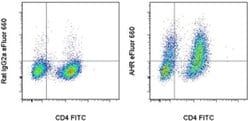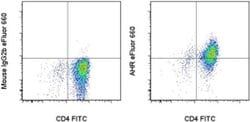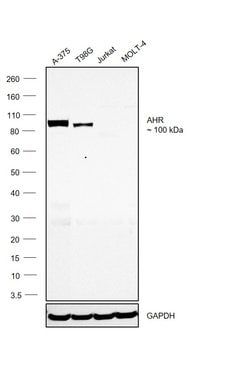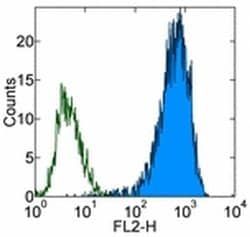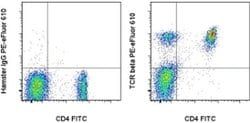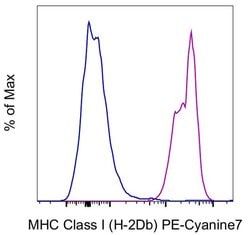25-592-580
AHR Monoclonal Antibody (4MEJJ), PE-Cyanine7, eBioscience™, Invitrogen™
Manufacturer: Invitrogen
Select a Size
| Pack Size | SKU | Availability | Price |
|---|---|---|---|
| Each of 1 | 25-592-580-Each-of-1 | In Stock | ₹ 19,224.00 |
25-592-580 - Each of 1
In Stock
Quantity
1
Base Price: ₹ 19,224.00
GST (18%): ₹ 3,460.32
Total Price: ₹ 22,684.32
Antigen
AHR
Classification
Monoclonal
Concentration
0.2 mg/mL
Formulation
PBS with 0.09% sodium azide; pH 7.2
Gene Accession No.
P30561
Gene Symbols
AHR
Immunogen
E. coli derived, His-tagged AHR (aa 443-805)
Quantity
25 μg
Primary or Secondary
Primary
Target Species
Mouse
Product Type
Antibody
Isotype
IgG2a κ
Applications
Flow Cytometry
Clone
4MEJJ
Conjugate
PE-Cyanine7
Gene
AHR
Gene Alias
Ah; Ah receptor; Ahh; Ahr; Ahre; AH-receptor; aromatic hydrocarbon receptor; aryl hydrocarbon receptor; aryl-hydrocarbon receptor; bHLHe76; Class E basic helix-loop-helix protein 76; dioxin receptor; In
Host Species
Rat
Purification Method
Affinity chromatography
Regulatory Status
RUO
Gene ID (Entrez)
11622
Content And Storage
4° C, store in dark, DO NOT FREEZE!
Form
Liquid
Description
- This 4MEJJ MAb recognizes mouse aryl hydrocarbon receptor (AHR)
- The AHR is a ligand-activated transcription factor that mediates the toxic effects of a diverse group of environmental contaminants, most notably aryl hydrocarbons such as polychlorinated biphenyls (PCB) and tetrachlorodibenzo-p-dioxin (TCDD)
- The AHR has also been shown to bind to a number of naturally occurring compounds found in fruits and vegetables as well as compounds generated through normal cellular metabolism
- AHR is localized in the cytoplasm in a complex that includes HSP90, p23, and XAP2/AIP/ARA9
- Upon ligand-binding, AHR translocates to the nucleus and binds with aryl hydrocarbon receptor nuclear translocator (ARNT), and this complex binds to the consensus DNA sequence, GCGTG, found in the promoter/enhancer regions of many genes such as CYP1A1
- The AHR is expressed in many cell types, with highest expression levels found in liver
- The AHR has been shown to play a role in the regulation/differentiation of Treg and Th17 cells
- The 4MEJJ MAb has been found to recognize the b-1, b-2 and d alleles of mouse AHR but does not crossreact with human AHR
- AHR (Ah Receptor) belongs to a family of proteins comprised of its dimerization partner ARNT (HIF-1 Beta) and the Drosophila proteins PER and SIM
- AHR contains an N-terminal sequence of approximately 200 amino acids termed the PAS domain
- AHR, found in a variety of tissues, binds to a specific DNA enhancer sequence and initiates transcription of the mRNA for the cytochrome P-450 (CYPIA1) gene
- The gene for AHR encodes a ligand-activated transcription factor involved in the regulation of biological responses to planar aromatic hydrocarbons
- AHR has been shown to regulate xenobiotic-metabolizing enzymes such as cytochrome P450, and its ligands included a variety of aromatic hydrocarbons
- AHR is a ligand-activated helix/loop/helix transcription factor found in a variety of vertebrate species
- The known ligands for AHR are foreign planar aromatic compounds, such as polycyclic aromatic compounds and halogenated aromatic compounds such as 2,3,7,8-tetrachlorodibenzo-p-dioxin (TCDD)
- Unlike the steroid/thyroid hormone receptors, there is no known physiological ligand for AHR
- Studies indicate that in non-ligand activated cells, AHR is found complexed with HSP90 predominantly in the cytoplasm
- Upon binding to an agonist, the ligand-activated AhR is believed to transform to a nuclear, DNA binding form, and this transformation process appears to involve dissociation of HSP90 from AhR followed by formation of a heterodimer with AhR nuclear translocator protein (Arnt)
- Diseases associated with AHR include eosinophilic fasciitis and seborrheic dermatitis.
Compare Similar Items
Show Difference
Antigen: AHR
Classification: Monoclonal
Concentration: 0.2 mg/mL
Formulation: PBS with 0.09% sodium azide; pH 7.2
Gene Accession No.: P30561
Gene Symbols: AHR
Immunogen: E. coli derived, His-tagged AHR (aa 443-805)
Quantity: 25 μg
Primary or Secondary: Primary
Target Species: Mouse
Product Type: Antibody
Isotype: IgG2a κ
Applications: Flow Cytometry
Clone: 4MEJJ
Conjugate: PE-Cyanine7
Gene: AHR
Gene Alias: Ah; Ah receptor; Ahh; Ahr; Ahre; AH-receptor; aromatic hydrocarbon receptor; aryl hydrocarbon receptor; aryl-hydrocarbon receptor; bHLHe76; Class E basic helix-loop-helix protein 76; dioxin receptor; In
Host Species: Rat
Purification Method: Affinity chromatography
Regulatory Status: RUO
Gene ID (Entrez): 11622
Content And Storage: 4° C, store in dark, DO NOT FREEZE!
Form: Liquid
Antigen:
AHR
Classification:
Monoclonal
Concentration:
0.2 mg/mL
Formulation:
PBS with 0.09% sodium azide; pH 7.2
Gene Accession No.:
P30561
Gene Symbols:
AHR
Immunogen:
E. coli derived, His-tagged AHR (aa 443-805)
Quantity:
25 μg
Primary or Secondary:
Primary
Target Species:
Mouse
Product Type:
Antibody
Isotype:
IgG2a κ
Applications:
Flow Cytometry
Clone:
4MEJJ
Conjugate:
PE-Cyanine7
Gene:
AHR
Gene Alias:
Ah; Ah receptor; Ahh; Ahr; Ahre; AH-receptor; aromatic hydrocarbon receptor; aryl hydrocarbon receptor; aryl-hydrocarbon receptor; bHLHe76; Class E basic helix-loop-helix protein 76; dioxin receptor; In
Host Species:
Rat
Purification Method:
Affinity chromatography
Regulatory Status:
RUO
Gene ID (Entrez):
11622
Content And Storage:
4° C, store in dark, DO NOT FREEZE!
Form:
Liquid
Antigen: MHC Class I (H-2Kb)
Classification: Monoclonal
Concentration: 0.2 mg/mL
Formulation: PBS with 0.09% sodium azide; pH 7.2
Gene Accession No.: P01901, P03991, P04223, P14428
Gene Symbols: H2-K1
Immunogen: __
Quantity: 25 μg
Primary or Secondary: Primary
Target Species: Mouse
Product Type: Antibody
Isotype: IgG2a κ
Applications: Flow Cytometry
Clone: AF6-88.5.5.3
Conjugate: PE-Cyanine7
Gene: H2-K1
Gene Alias: class I major histocompatibility antigen H-2Kd; H-2 class I histocompatibility antigen, K-B alpha chain; H-2 class I histocompatibility antigen, K-D alpha chain; H-2 class I histocompatibility antigen, K-K alpha chain; H-2 class I histocompatibility antigen, K-Q alpha chain; H-2 class I histocompatibility antigen, K-W28 alpha chain; H-2K; H2-K; H-2K(B); H-2K(d); H-2K(K); H-2K(Q); H2-K1; histocompatibility 2, K1, K region; K-f; MHC class I antigen; MHC class I H2-K-b-alpha-2 cell surface glycoprotein; MHC class I heavy chain H2-K; MHC H2-K transplantation antigen
Host Species: Mouse
Purification Method: Affinity chromatography
Regulatory Status: RUO
Gene ID (Entrez): 14972
Content And Storage: 4° C, store in dark, DO NOT FREEZE!
Form: Liquid
Antigen:
MHC Class I (H-2Kb)
Classification:
Monoclonal
Concentration:
0.2 mg/mL
Formulation:
PBS with 0.09% sodium azide; pH 7.2
Gene Accession No.:
P01901, P03991, P04223, P14428
Gene Symbols:
H2-K1
Immunogen:
__
Quantity:
25 μg
Primary or Secondary:
Primary
Target Species:
Mouse
Product Type:
Antibody
Isotype:
IgG2a κ
Applications:
Flow Cytometry
Clone:
AF6-88.5.5.3
Conjugate:
PE-Cyanine7
Gene:
H2-K1
Gene Alias:
class I major histocompatibility antigen H-2Kd; H-2 class I histocompatibility antigen, K-B alpha chain; H-2 class I histocompatibility antigen, K-D alpha chain; H-2 class I histocompatibility antigen, K-K alpha chain; H-2 class I histocompatibility antigen, K-Q alpha chain; H-2 class I histocompatibility antigen, K-W28 alpha chain; H-2K; H2-K; H-2K(B); H-2K(d); H-2K(K); H-2K(Q); H2-K1; histocompatibility 2, K1, K region; K-f; MHC class I antigen; MHC class I H2-K-b-alpha-2 cell surface glycoprotein; MHC class I heavy chain H2-K; MHC H2-K transplantation antigen
Host Species:
Mouse
Purification Method:
Affinity chromatography
Regulatory Status:
RUO
Gene ID (Entrez):
14972
Content And Storage:
4° C, store in dark, DO NOT FREEZE!
Form:
Liquid
Antigen: Nur77
Classification: Monoclonal
Concentration: 0.2 mg/mL
Formulation: PBS with 0.09% sodium azide; pH 7.2
Gene Accession No.: P12813
Gene Symbols: NR4A1
Immunogen: __
Quantity: 100 μg
Primary or Secondary: Primary
Target Species: Mouse
Product Type: Antibody
Isotype: IgG1 κ
Applications: Flow Cytometry
Clone: 12.14
Conjugate: PE-Cyanine7
Gene: NR4A1
Gene Alias: early response protein NAK1; Gfrp; GFRP1; growth factor-inducible nuclear protein N10; Hbr1; Hbr-1; Hmr; hormone receptor; immediate early gene transcription factor NGFI-B; MGC9485; N10; NAK1; NAK-1; nerve growth factor IB nuclear receptor variant 1; nerve growth factor induced protein I-B; nerve growth factor-induced protein I-B; Ngfib; NGFI-B; NP10; Nr4a1; Nuclear hormone receptor NUR/77; nuclear protein N10; Nuclear receptor subfamily 4 group A member 1; nuclear receptor subfamily 4, group A, member 1; NUR77; Orphan nuclear receptor HMR; orphan nuclear receptor TR3; Orphan receptor tr3; ST-59; steroid receptor TR3; testicular receptor 3; TIS1; TR3; TR3 orphan receptor
Host Species: Mouse
Purification Method: Affinity chromatography
Regulatory Status: RUO
Gene ID (Entrez): 15370
Content And Storage: 4° C, store in dark, DO NOT FREEZE!
Form: Liquid
Antigen:
Nur77
Classification:
Monoclonal
Concentration:
0.2 mg/mL
Formulation:
PBS with 0.09% sodium azide; pH 7.2
Gene Accession No.:
P12813
Gene Symbols:
NR4A1
Immunogen:
__
Quantity:
100 μg
Primary or Secondary:
Primary
Target Species:
Mouse
Product Type:
Antibody
Isotype:
IgG1 κ
Applications:
Flow Cytometry
Clone:
12.14
Conjugate:
PE-Cyanine7
Gene:
NR4A1
Gene Alias:
early response protein NAK1; Gfrp; GFRP1; growth factor-inducible nuclear protein N10; Hbr1; Hbr-1; Hmr; hormone receptor; immediate early gene transcription factor NGFI-B; MGC9485; N10; NAK1; NAK-1; nerve growth factor IB nuclear receptor variant 1; nerve growth factor induced protein I-B; nerve growth factor-induced protein I-B; Ngfib; NGFI-B; NP10; Nr4a1; Nuclear hormone receptor NUR/77; nuclear protein N10; Nuclear receptor subfamily 4 group A member 1; nuclear receptor subfamily 4, group A, member 1; NUR77; Orphan nuclear receptor HMR; orphan nuclear receptor TR3; Orphan receptor tr3; ST-59; steroid receptor TR3; testicular receptor 3; TIS1; TR3; TR3 orphan receptor
Host Species:
Mouse
Purification Method:
Affinity chromatography
Regulatory Status:
RUO
Gene ID (Entrez):
15370
Content And Storage:
4° C, store in dark, DO NOT FREEZE!
Form:
Liquid
Antigen: MHC Class I (H-2Db)
Classification: Monoclonal
Concentration: 0.2 mg/mL
Formulation: PBS with 0.09% sodium azide; pH 7.2
Gene Accession No.: P01895, P01896, P01897, P01899, P01900, P14426, P14427
Gene Symbols: H2-D1
Immunogen: __
Quantity: 25 μg
Primary or Secondary: Primary
Target Species: Mouse
Product Type: Antibody
Isotype: IgG2a κ
Applications: Flow Cytometry
Clone: 28-14-8
Conjugate: PE-Cyanine7
Gene: H2-D1
Gene Alias: H-2 class I histocompatibility antigen, D-B alpha chain; H-2D; H2-D; H-2D cell surface glycoprotein; H-2D(B); H2D1; H2-D1; H2DB; H2-DC1-beta transplantation antigen protein; H2L; H2LD; histocompatibility 2, D region locus 1; MHC class I antigen; MHC class I H2 antigen; MHC class I H-2Dp; MHC H2-D-q alpha-chain; Q5k protein
Host Species: Mouse
Purification Method: Affinity chromatography
Regulatory Status: RUO
Gene ID (Entrez): 14964
Content And Storage: 4° C, store in dark, DO NOT FREEZE!
Form: Liquid
Antigen:
MHC Class I (H-2Db)
Classification:
Monoclonal
Concentration:
0.2 mg/mL
Formulation:
PBS with 0.09% sodium azide; pH 7.2
Gene Accession No.:
P01895, P01896, P01897, P01899, P01900, P14426, P14427
Gene Symbols:
H2-D1
Immunogen:
__
Quantity:
25 μg
Primary or Secondary:
Primary
Target Species:
Mouse
Product Type:
Antibody
Isotype:
IgG2a κ
Applications:
Flow Cytometry
Clone:
28-14-8
Conjugate:
PE-Cyanine7
Gene:
H2-D1
Gene Alias:
H-2 class I histocompatibility antigen, D-B alpha chain; H-2D; H2-D; H-2D cell surface glycoprotein; H-2D(B); H2D1; H2-D1; H2DB; H2-DC1-beta transplantation antigen protein; H2L; H2LD; histocompatibility 2, D region locus 1; MHC class I antigen; MHC class I H2 antigen; MHC class I H-2Dp; MHC H2-D-q alpha-chain; Q5k protein
Host Species:
Mouse
Purification Method:
Affinity chromatography
Regulatory Status:
RUO
Gene ID (Entrez):
14964
Content And Storage:
4° C, store in dark, DO NOT FREEZE!
Form:
Liquid
